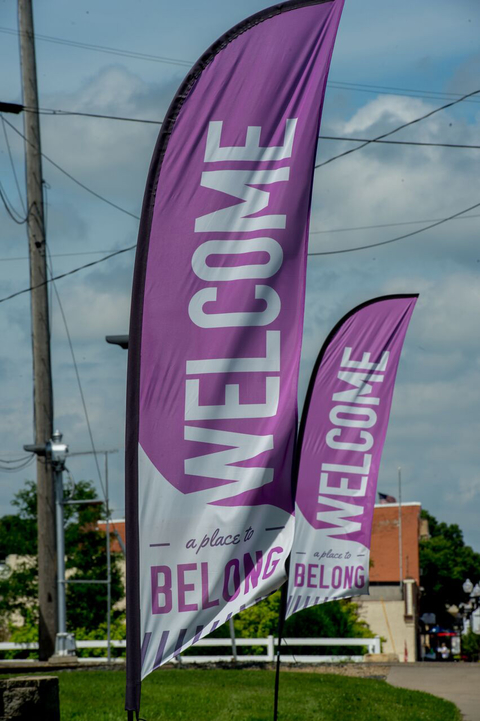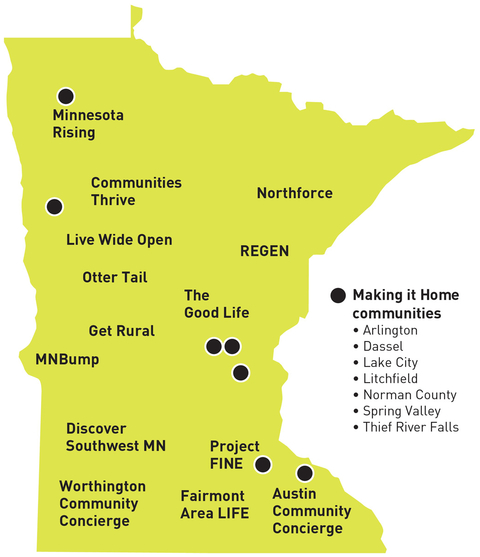Newcomers to Minnesota sometimes joke that “Minnesotans will give you directions to everywhere but their house.” But community leaders across the state are trying to change that. They’re designing regional campaigns that welcome newcomers to visit, live, work and get connected.
It’s not just the "Minnesota nice" thing to do. It’s solid economic development strategy. Turns out, newcomers bring communities more than exotic potluck dishes. They add workers to a depleted workforce and children to school districts. A 2010 Extension analysis found that newcomer spending added $9.1 million to one rural regional economy, including 174 jobs and $7.2 million in labor income. And Extension’s 2016 examination of rural business succession found that 33 percent of those who bought rural businesses were new to town; an additional 12 percent had returned to their hometown to take over a business.
Extension’s research has inspired rural leaders. They are actively marketing their rural communities and are intentionally welcoming newcomers. “Rural leaders are ready to try new things,” says Ben Winchester, an Extension educator who has spread the word that rural places are attracting 30-49 year olds. In response, 14 initiatives throughout the state are focused on resident recruitment and retention. And rural towns are developing local recruitment initiatives through Extension’s Making it Home program.
In 2017 and 2018, Extension conducted in-depth interviews to find out what community leaders are learning from these initiatives. Here, we share a summary of what they said are the essential ingredients of rural resident attraction and retention.
Rural resident recruitment – key ingredients
Connect online
Extension-led focus groups with newcomers in 2010 found that most newcomers started their search for a new community with a general idea of the area they wanted to live in, and then went online to find a town that met their needs. So initiatives are using social media, online campaigns and websites to find the browsers who are shopping online for rural towns. Hashtags like #GetRuralMN promote a positive narrative of rural living.
Promote the simple life
“People migrate to rural communities for a number of reasons,” says Winchester. “Their number one reason is to improve their quality of life and to live a simpler life.” The Live Wide Open campaign shows the world how good quality of life can be in West Central, Minnesota. Its website features newcomers who are glad they made the move. Newcomer testimonies describe how moving improved their lives:
“Last winter I got stuck and… neighbors were there to help.”
“We have three dogs and they run around outside no problem.”
“The stars. You can see the stars. You forget they exist when you live in the Twin Cities.”
Make a connection
Initiative leaders know it takes more than just “buzz” to attract a resident. “Once somebody gets in the funnel as a prospective employee or resident, you’ve got to make sure that that individual gets one-on-one interaction,” says Mike Bjerkness from the Brainerd Lakes Area Economic Development Corporation. “Whether it’s a phone call, an email, or a Facebook message.” Each initiative has put strategies in place to make a connection. They assure those who are thinking about moving that they can make a life in rural areas.
Bring people to jobs — and jobs to people
Rural employers want to attract good workers, but employers don’t always promote the positive aspects of the community as they recruit workers. So community leaders are stepping in, helping employers show prospective employees what’s great about the community.
They are also helping newcomers find the jobs they need. “Many newcomers — highly motivated to improve their quality of life — take a risk and move to town without a job,” says Winchester. “But once they get there, they need to make money.” In the Upper Minnesota Valley area, initiative leaders hope to become a one-stop source of information about jobs, housing and family opportunities.
“A head in the bed, even if it’s for two nights, is a potential resident someday.”
- Erik Osberg
Get people hooked through tourism
The first step to getting people to live in a community might be to get them to visit. Cynthia Messer, Extension’s Tourism Center Director, notes that research has found a link between tourism experiences and resident attraction. It's called the Halo Effect. “Minnesota is particularly good at this,” says Messer, noting that, “After visiting Minnesota, people are far more likely to say Minnesota is a good place to live, to start a career or to retire.”
In Otter Tail County, the Rural Rebound initiative integrates resident recruitment into tourism outreach. Erik Osberg, who works with the initiative, puts this succinctly. “A head in the bed, even if it’s for two nights, is a potential resident someday.”
Create welcoming experiences
“If we don’t connect newcomers and their families to the community in the first six months, there’s a chance we’re going to lose them,” says Bjerkness. He has expanded his job description to include helping newcomers feel welcome. In Otter Tail County, Osberg recruits volunteers to make a connection with new residents in the “Grab-a-Bite” program. “We ask champions to take newcomers to lunch — and tell them not to pressure newcomers to join any particular groups or volunteer, but just to get to know them.”
“Technology has made it possible for people to find rural areas, but technology also makes it possible for them to maintain deep attachments to the organizations and people they left behind,” says Winchester. “So community leaders shouldn’t assume that every new resident is a potential Lions Club member. A good first step is to just listen; to get to know them as people and to discover their interests.”
The sticky factor
Newcomers face resistance, sometimes, from established residents. Initiatives like ReGEN and Fairmont Area Life make an effort to help newcomers find places where they will feel welcome and share common interests. ReGEN connects millennials who have moved to the Iron Range. “Millennials look beyond the 9 to 5,” says Jessalyn Sabin, ReGen leader. “They’re interested in finding a place that they feel welcomed… We feel really strongly that the Iron Range is a vibrant place. It’s got an amazing history and there’s a lot of opportunity here. With more social roots, we’re hoping people can … have some stake in the community.”
Address the essentials
Rural areas are facing critical issues when it comes to essentials like housing and child care. And finding essential services can be especially difficult when English is not a newcomers’ first language.
“We see leaders of rural recruitment initiatives getting deeply involved in critical issues of community and economic development," says Winchester. "They are at the table when it comes to housing problems, Main Street development, transportation issues, and more.” Services and cultural assets are another critical need for immigrant newcomers. “These initiatives can bring the voices of newcomers and their concerns to policymakers and businesses who are investing in the community. Because newcomers are more than new neighbors — they are the community’s future workforce and life blood.”
Challenges to attracting and retaining newcomers:
- Jobs are available in rural areas, but there aren’t enough centralized jobs databases that connect those looking to move to an area with jobs located there.
- Newcomers need better ways to discover all community opportunities.
- Housing, public transportation, and services for immigrants are sometimes lacking. This is even tougher for those whose first language isn’t English.
- Resistance from long-term residents. It can be a challenge to break into established communities.
- Getting workers to take a job may require convincing workers that a rural place is for them.
Hannah Bohn, Extension former research assistant; Fernando Burga, assistant professor, Humphrey School of Public Affairs; Scott Chazdon, Extension evaluation and research specialist; Neil Linscheid, Extension educator, community economics; Ben Winchester, Extension educator, community economics



